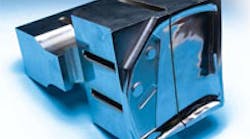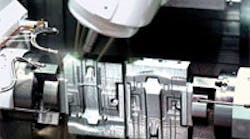Branson Ultrasonics spends less time polishing its tooling for ultrasonic welding since it installed two Bridgeport machining centers.
Branson Ultrasonics Corp. (www.bransonultrasonics.com) builds the tooling (horns and fixtures) to allow its customers to ultrasonically weld plastic parts themselves. It is not a high volume business, but one that is primarily one-of-a-kind. It is for situations in which time-to-market is extremely critical. In most cases, horn and fixture job sizes comprise one or two pieces that must be made precisely to ensure perfect welds in customers’ products.
Branson Ultrasonics works such materials as titanium and aluminum.
Its machining times vary from a few hours to days, depending on the size and complexity of the tool, and as a final step, the shop must polish horns and fixtures until their surfaces fit together precisely while perfectly matching the surfaces of the plastic parts they will be welding. With this said, any machining center that produces a better surface finish prior to polishing and a surface finish that more accurately reproduces a customer’s part shape will reduce polishing times dramatically for Branson Ultrasonics.
Two such machines are the Bridgeport 760XP3 and the Bridgeport 610XP3, both vertical machining centers from Hardinge (www.hardinge.com).
Prior to using the Bridgeports, the shop spent 60 min. to 90 min polishing an average horn. The job now takes about half the time because, according to John Powers, manufacturing manager at Branson Ultrasonics, the Bridgeports are fast, especially when it comes to transmitting data.
Branson Ultrasonics’ data files can run upwards of 30 or 40 meg.
“What the Bridgeports’ Fanuc 18i MB controls allow me to do is to create extremely tight, dense point clouds, so stepovers from slice to slice as we traverse the part are very small, making for a finer finish and significantly reducing our polishing time,” explained Powers.
According to Hardinge, machine starvation is nonexistent with the Fanuc 18i MBs on the Bridgeports. Data literally flies from the control to the machine drives to keep productivity up and to help reduce the chances of process interruptions. Powers said that, as a result, he can run at 80 ipm to 100 ipm, compared with running at 35 ipm to 40 ipm with the machines that he used previously. And, the previous machines still caused Powers to worry about starvation alarms that could stop the job.
Branson Ultrasonics’ Bridgeports also sport two optional Renishaw (www.renishaw.com) probes and throughthe- spindle coolant. The two probes speed part setups and help to locate exactly where contours are going to be placed on horns. One probe is used for tool setting; the other is used for workpiece inspection. With the machines’ throughspindle coolant pumping at 290 psi, the shop can machine deep contours safely with adequate chip flushing while using small cutters. That helps it to improve surface finishes for those deep contours.







